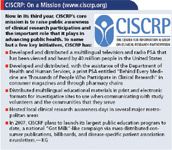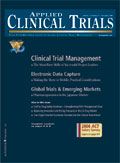Lessons from the Organ Donation Playbook
Applied Clinical Trials
Successful efforts of the organ donation sector could serve as a model for rebuilding public trust.
From most all accounts in the popular press today, much appears to be wrong with the clinical research enterprise: professional greed, human errors and tragic patient deaths, conflicts of interest, data disclosure failures, the apparent concealment of information, and lax federal oversight.

Kenneth A. Getz
Spending on patient recruitment promotion programs is high and rising at the same time that enrollment and retention rates are worsening. Recruitment ads are being met more by fear and suspicion among prospective study volunteers than by curiosity and interest. And according to numerous polls and surveys, public trust in the pharmaceutical industry, the National Institutes of Health, and academic research centers has eroded. Physicians and other health care professionals, for the most part, are not referring their patients to clinical trials.
How is this beleaguered enterprise to repair and reshape its broken image? In part by borrowing lessons from an analogous health care sector: organ donation. Clearly there are many ways that these two sectors differ. But there are also numerous similarities that bear a striking resemblance to the challenges that the clinical research enterprise now faces.
Image repair
Two decades ago the organ donation movement suffered from poor public perception, low awareness, and low trust. Politicians and activists were upset by a series of medical errors that resulted in patient injuries and deaths. Practicing clinicians were having trouble finding organs and donors. And those that were available were being inequitably distributed in hospital emergency rooms.

CISCRP: On a Mission (www.ciscrp.org)
Organizations involved in clinical research, much like organ procurement organizations (OPOs), "Seek an audience with people about the opportunity to do something that...contributes to the world around them," said Tom Mone, CEO of Los Angeles-based One Legacy, the nation's largest OPO. "In both cases, people need to voluntarily take action and think doing so is worthwhile. This was at the core of repairing the image of organ donation and had to be addressed on many levels and across many fronts," he said.
Since the mid-1980s, the organ donation enterprise has nearly quadrupled the level of volunteerism and public support. In 1984, a mere 6900 organs were donated nationally. In 2004, 26,000 organs were donated. Although this level is still well below the nation's current need, it represents a substantial improvement over that seen 20 years ago. All stakeholders in the clinical research enterprise can learn from the experiences of the organ donation sector.
To begin, both government and private sectors recognized the organ shortage as a national and collective problem. Working collaboratively, they countered it on a national scale with public service announcements (PSAs) and local outreach/education programs.
PSAs focused on building national pride in organ donation and in acknowledging the profound gift that donors give. New state laws allowed people to designate themselves as informed and willing organ donors on their drivers' licenses. Nonprofit organizations sprung up to teach hospitals how to communicate more effectively with families facing the challenging decision whether to harvest the organs of loved ones on the brink of death.
Legislative lessons
Federal legislation was enacted. The National Organ Transplant Act of 1984 effectively created a registry where clinicians could quickly check organ availability and wait times. It also declared organ donation an altruistic act by outlawing the purchase and sale of human organs. This act was followed in 1991 by legislation that encouraged the use of advance directives and durable powers of attorney for health care. In 1999 came the Donor Leave Act that gave federal employees paid time off from work to be a living organ donor. More importantly, that same year the Medicare program mandated that hospitals refer all potential donors to an OPO.
The personal stories of organ recipients were critical messages, then and now, to would-be donors and to the lay public. "There has always been a fair amount of resistance to the idea of donating organs, as was first quantified by researchers in the late 1970s," added Mone. "One study determined that 90% of people say they believe donation is a good idea, but only 40% say 'yes' at the time they really have to make a decision. That is, it's a great idea for someone else." Personal stories put a face on the problem and showed how organ donation improved the quality of, or saved, a life. At the present time, the public holds a similar view of clinical research: A high percentage believe it is important to advancing medical science; but only a small percentage are willing to participate.
Reaching out
Organ donation rates began to rise during the 1990s, predominantly among multigenerational English-speaking communities. But in large ethnically diverse, nonEnglish-speaking communities like Southern California, organ donation rates languished. "There was a strong move at that time to use 'ethnically like' requesters who spoke the same language and, ideally, had some familiarity with the culture of potential donors and their families," said Mone. "People from other cultures aren't familiar with organ transplantation and donation like someone who has lived in this country for many years, so we needed different messages sensitive to cultural issues surrounding death and dying."
"It was an enormously successful strategy for One Legacy and other OPOs," says Mone. "Between 2000 and 2006, the consent rate rose from less than 20% to nearly 40% among Asian Americans, from 30% to about 45% among African Americans, and from 35% to more than 60% among Hispanics. In the Anglo community, the consent rate runs upwards of 65%," he explained.
"The organ donation movement is now also gaining steam from the three-year-old Organ Donor Breakthrough Collaborative, sponsored by the Division of Transplantation within the Department of Health and Human Services," said Mone. "Key leaders and practitioners from the nation's transplantation and hospital communities came together to spread known 'best practices' to achieve organ donation rates of 75% or higher at the 200 largest U.S. hospitals. The conversion rate of eligible to actual donors has already moved from 45% to 60% nationwide," he said. "The seed money comes from the federal government for the big training sessions, but participation is funded by OPOs and by the private sector."
One Legacy and other OPOs are now making a case for organ donation with an outreach program targeting a younger public: high school students. "The program is typically tied to the science curriculum and involves a couple of classroom visits to talk about organ donation and share donor/transplant stories," said Mone. "Kids are very impressionable and they hear messages that will stay with them for a long time," he said.
Positive press
"In the past year, we've had all sorts of stories about aberrant acts of a few transplant centers," Mone said. "These isolated episodes of misconduct overshadow the good news." The OPO counteroffensive is a national marketing campaign spearheaded by Donate Life America (DLA), a Richmond, VA-based not-for-profit alliance. The DLA works with the private, nonprofit Ad Council to produce PSAs and promulgate positive donor/transplant stories that OPOs help distribute to local newspapers and television stations. "Each transplant center makes a monetary contribution annually and the Ad Council does pro bono work," said Mone.
The Donate Life float will make its fourth appearance in the Rose Parade on New Year's Day 2007. "The advantage is you get your 30–40 seconds on national TV but, more importantly, the inspirational 'Oprah' kind of stories of transplant recipients riding the float get told multiple times in the local and national media several weeks before and after the event," said Mone.
"It has been a long road to reach this level of success," said Kadiyala Ravindra, MD, a transplant surgeon at the University of Louisville School of Medicine. "The main factors were legislation allowing doctors to harvest organs from brain dead individuals and the advent of antirejection medications that drastically improved the odds of a successful transplant. Stories of those successful transplants have regularly appeared in the press, such as that of the first ever transplant Olympian Chris Klug," he said.
"Patients once doomed to die receive a new lease on life, and that has changed society's perception of organ donation. When they see and understand the good that can come out of it, then they want to support and contribute to it," added Ravindra.
Building a movement
There is ample evidence showing that once study volunteers participate in clinical trials, their understanding of the research process and the perceived value of participation increases dramatically. In addition, the vast majority of study volunteers report that they would be very willing to participate in another clinical trial if appropriate. Study volunteer sentiments gleaned from recent trial close-out interviews—"I saw it as an opportunity to help others and advance science" and "I gained access to an experimental treatment that gave me hope"—are widely shared by those who have been through a trial participation experience. Unfortunately, these sentiments and experiences are rarely headline-grabbing quotes destined for the New York Times or the Washington Post.
Arguably, in recent years the clinical research enterprise has primarily focused on ensuring professional compliance with federal clinical research guidelines, on improving the capacity and capabilities of human subject protection programs, on minimizing conflicts of interest, and on creating incentives designed to promote the disclosure of research information. These are important initiatives, but they do not directly reach out to the lay public and health care provider communities. To date, little attention has been paid to building collaborative government–private sector efforts focusing on educating and engaging these communities as clinical research partners. And nearly all of these initiatives are being implemented independently by the public and private sectors—there has typically been little to no real collaboration.
Collaborative efforts
During the past several years, the NIH, FDA, foundations, and associations have begun hosting meetings designed to facilitate a dialogue between clinical research professionals from the public and private sectors. The Center for Information and Study on Clinical Research Participation (CISCRP), an independent nonprofit organization that I am privileged to be a part of, has been implementing a variety of collective outreach activities (see sidebar) in an effort to build momentum along the same lines as that created by the organ donation sector.
Much more needs to be done, and sufficient funding needs to be raised, to promote and support a truly collective government–private sector movement; to inspire and facilitate federal legislation designed to recognize and honor those individuals who have given the gift of clinical research participation; and to provide wider-reaching education—sensitive to ethnic and cultural diversity—to raise awareness and inform patients and the lay public about the important role that clinical research participation plays in advancing health.
But we need not reinvent the wheel. One need not look further than the lessons learned from the organ donation playbook to identify specific ways to improve public awareness, trust, and engagement in clinical research. The next critical step is to adequately support, and successfully implement, these important lessons.
Kenneth A. Getz MS, MBA, is a Senior Research Fellow at the Tufts CSDD and Chairman of CISCRP, both in Boston, MA, email: kenneth.getz@tufts.edu

FDA Fast Tracks Johnson & Johnson’s Nipocalimab for Fetal Neonatal Alloimmune Thrombocytopenia
March 27th 2024Johnson & Johnson is moving forward with a pair of Phase III trials of nipocalimab to reduce the risk of fetal neonatal alloimmune thrombocytopenia in alloimmunized pregnant patients.
Citius Pharmaceuticals Resubmits BLA to FDA for Lymphir to Treat Cutaneous T-Cell Lymphoma
March 19th 2024Pivotal Phase III Study 302 trial data show an objective response rate of 36.2% based on an independent review committee assessment in the treatment of relapsed/refractory cutaneous T-cell lymphoma.